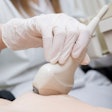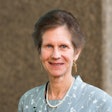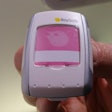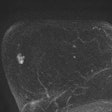
VIENNA - Radiologists have long been behind-the-scenes physicians, reading exams in darkened basements. But this paradigm isn't viable anymore in an age of increasingly competitive healthcare delivery, and radiologists must be proactive about boosting their visibility, according to a presentation on Friday at ECR 2017.
Becoming more visible isn't about magic, but about hard work, said Dr. Nicola Strickland, president of the Royal College of Radiologists (RCR). And the consequences of inaction could be dire.
"It's largely up to us to raise our profile -- there are no fairy godmothers out there who are going to do it for us," she said. "We ourselves need to make sure our colleagues appreciate that we're a valuable part of the clinical team."
Dark future?
 RCR President Dr. Nicola Strickland.
RCR President Dr. Nicola Strickland.What will happen if radiologists do not take the initiative? For starters, the specialty will be increasingly relegated offsite and focused on output, Strickland cautioned.
"We will be forced to give up everything except generating reports," she said. "That would be pretty soul-destroying. We're trained to do far more than that."
Another possible future is that specialists will perform the imaging needed for their field.
"If we don't raise our profile, a highly likely outcome will be that each specialty will master its own imaging," she said. "We must work to be better if we're going to survive, and the way we can be better is to maintain general radiology training but also develop specialist expertise."
Finally, nonphysician staff such as radiographers, nurses, and even occupational therapists could take on more imaging duties, especially when departments are faced with a shortage of radiologists. Possible consequences include descriptive rather than diagnostic reports -- which aren't of much use to referring physicians.
"It may be cheaper, but the money is wasted, since referring physicians aren't going to look at reports that [describe features] any of them could see themselves," Strickland said.
Strickland shared a number of suggestions for radiologists to increase their visibility among referring physicians, patients, and hospital managers.
Clinical colleagues
"Radiologists must involve themselves in a wide gamut of clinical activity," Strickland said. "That's really the bottom line for raising our visibility. We do it already -- we just have to do it more, and make it more obvious." She offered the following advice:
- Write meaningful, diagnostic, and actionable reports, and follow through on urgent or unexpected results. "If we are worried about a patient, we need to get in touch with the referrer," she said.
- Interventional radiologists can institute clinics for patient assessment and follow-up, look for direct referrals from general practice physicians, do their own ward rounds, and offer their diagnostic skills to managing doctors. "Let's act like the doctors that we are, and not leave it to others," she said. "Yes, it requires effort and time, but unless we're prepared to do that, we're not going to survive in the long term."
- Participate in multidisciplinary team meetings and make time for face-to-face discussions with referring physicians. "Team meetings give us a platform to present the imaging, to be the center of the meeting," she said. "We are integral to those meetings, and we need to exploit that."
- Institute intensive care ward rounds. "It's very helpful for intensive care physicians to have expert advice because their patients change rapidly from day to day," Strickland said.
- Teach medical students and junior doctors. "Right from medical school level, let's help students realize that what they really want to do is radiology," she said.
- Participate in multidisciplinary research. "Get to know your colleagues and join in their research," she said. "Don't let them use the imaging without giving us any credit."
- Take leadership roles on hospital committees. "We need to step up to the plate and take on leadership roles," she said.
Patients
Seize every opportunity to educate the public that radiologists are doctors, Strickland said.
"If you get into a taxi and the driver says, 'Oh, what do you do?' you can say, 'Well, I'm a radiologist -- we are doctors,' " she said. "Most of the public doesn't know that we are medical doctors."
Strickland also suggested radiologists do the following:
- Consider sending patients their reports, although there are several cautions to consider. These include whether the report's medical language is understandable for patients, whether the findings reported could cause unnecessary alarm, and whether patients might learn of serious health conditions such as cancer without appropriate support.
- Offer patients clinic consults to review their imaging results. This idea comes with some logistical concerns, including making time for this kind of consult and getting paid for it, Strickland said. But a pilot program at Massachusetts General Hospital in Boston has shown high patient satisfaction. "Patients are very satisfied with seeing their images, and it helps them to better understand and cope with their diseases," she said.
Hospital managers
Radiologists should get involved with management. "It's not something we should be leaving to others," Strickland said. She advised the following:
- Consider what managers want: No drama, no complaints, no risks, and professional success. "They want happy patients and happy radiologists," she said. "We can help managers achieve what they want because, in fact, we want the same things."
- Avoid reporting backlogs. "Develop job plans and stick to them," she said.
- Establish good end-to-end IT. "You need an electronic results feedback system so there are no missed reports," Strickland said. "And referring physicians need one-click access to reports."
- Develop new income-generating ideas, such as expert specialist services like cardiac MRI.
No fairy godmothers
It's important for radiologists to understand that the future of the field is theirs for the making, Strickland concluded.
"We need to increase our visibility in every domain -- with clinical colleagues, patients, and managers -- so that we're not taken for granted and left in the background," she said. "We must help ourselves. Our destiny is in our own hands."


















